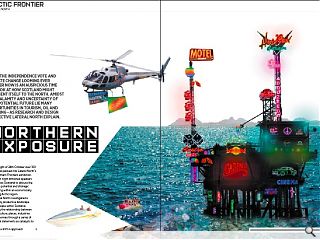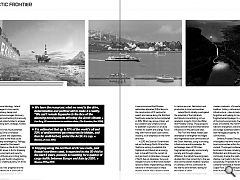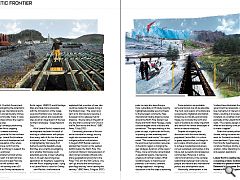Lateral North
13 Jan 2014
With the independence vote and climate change looming ever larger now is an auspicious time to look at how Scotland might reorient itself to the north. Amidst the calamity and uncertainty of this potential future lie many opportunities in tourism, oil and shipping - as research and design collective Lateral North explain.
On the night of 24th October over 100 individuals packed into Lateral North’s New Northern Frontiers exhibition. The event night attracted speakers from across Scotland to discuss the country’s potential and strategic positioning within an economically emerging Arctic region.Lateral North investigated a potentially productive landscape and seascape within Scotland, exploring the relationship between people, culture, places, industries and economies through a series of polemical statements as catalysts to discuss.
With a shift in approach and traditional ideology, Lateral North engages in cross-sector, multidisciplinary design and research and encourages discovery, investigation and testing of previously over-looked opportunities to engage people in long-term, strategic, holistic visioning.
The Arctic has much potential considering China’s increased economic power and capabilities, greater access to the West could prove hugely advantageous. Tellingly, China has asked for Permanent Observer Status on the Arctic Council, dealing with issues in Arctic shipping, energy, environment and security. Canada and Russia are circling, testing and drilling and the EU is beginning first step to creating a policy on Arctic issues.
However, how prepared are the northern nations for a gold rush of 21st century proportions? In 2011 it was announced that Russian authorities allocated 21.8m Euros to the construction of 10 centres for search and rescue along the Northern Sea Route, expected to be completed in 2015. What may prove critical, will be Scotland’s pre-emptive moves to establish its position on a future frontier for wealth and energy. Focus may shift from an east coast-centric industry, to an emphasis on the north and west.
In 2013 the Scottish Government set up the Energy North Oil and Gas Taskforce, aiming to establish the Highlands and Islands as an energy hub, to benefit from the current oil and gas boom in Aberdeen. However, if North Sea oil dissipates, focus will instead move to northern and western resource fields. Implementing a strong network of infrastructure in these regions will not only support current industry but will future-proof industry in marine services, fabrication and production in local communities.
Lateral North initially investigated the potential of the Highlands and Islands concentrating on two academic projects; From the Water and Possible Orkney. These projects looked at both local and international influences on the particular sites.
The From the Water master plan attempted to strengthen the fragile and fragmented rural communities of the Outer Hebrides, using its existing infrastructure and knowledge. An archipelago chain of 130 miles, fragmented physically, economically, socially and through religious affiliation, the islands have long been divided. But, their proximity to the sea and communitarian tradition resulted in a shared, intrinsic connection to the marine environment, lasting for thousands of years.
It is this shared connection that creates a network: of knowledge, tradition, history, culture and infrastructure - close to being forgotten and helping to mend the fragmented archipelago. In one of the most economically fragile areas of Scotland, the maritime network strengthens old and new: to encourage sustained, balanced and well managed prosperity for the local communities.
Similarly Possible Orkney investigated maritime industry and local communities within the projects context. The largest container terminals in Europe including Rotterdam and Antwerp must continually dredge the relatively shallow river beds to function successfully. Proposals for shipping container terminals at Hunterston and Scapa Flow, Orkney, have previously been illustrated in the Scottish Government’s National Planning Framework (Scottish Government, 2009). Investigating the potential to be exciting new international ports, Hunterston and particularly Orkney would accommodate Triple -E class container ships without the need to dredge the sites.
Orkney’s strategic positioning within a new Arctic shipping region has created enormous economic potential for the northern archipelago. Lateral North believes this infrastructural development will require a population influx where Scots will move north from the central belt to Orkney to support the increasing workload.
The container terminal will be an integral part of a light rail loop wrapping around Scapa Flow bay. This light rail will connect new industries will develop over a 50 year period as Orkney harnesses its strategic location within the emerging Arctic region. UNESCO world Heritage Sites are made more accessible with the introduction of the Scapa Loop and Pentland Line. Industries, population centres and recreational sites are all an integral part of the new northern landscape - Scapa Network City.
All of Lateral North’s research and development has been the result of working in collaboration with people from every walk of life, but the ideas are based on fact. Something which is highlighted by Stornoway Port Authority and the feasibility study that they are currently investigating as to whether Stornoway could potentially provide a major refuelling hub, in 20 years becoming a key destination for freighters, supporting the new Arctic shipping routes – tying in to Lateral North’s vision for Orkney.
Jane MacIver, chief executive at Stornoway Port Authority also explained that a number of new jobs could be created for people living in the Western Isles. “The vision long-term is for Stornoway to become a European Arctic gateway hub for shipping. ..We are bang in the path of any ship that is coming from China or the Far East across the Arctic.” (BBC News, 11 July 2013)
Conversely, promises of fortune and a scramble for energy security might also increase tension and instigate political confrontation. In August 2007 Russian explorers planted their tricolor on the seabed 4200m below the North Pole. This rust-proof, titanium-clad expression of claim stirred Canadian officials (who share geographical proximity to the Pole), “This isn’t the 15th Century...You can’t go around the world and just plant flags and say ‘we’re claiming this territory.” (BBC News, 3 August 2007)
Tension, confrontation and melting polar ice caps also leave Europe more vulnerable. A UN study recently highlighted possible security threats to the European community. New international trading shipping routes around the North Pole, Eastern Sea Route and North West Passage, create a double edged sword of access and connection. “The rapid melting of the polar ice caps, in particular the Arctic, is opening up new waterways and international trade routes,” the report noted. “The increased accessibility of the enormous hydrocarbon resources in the Arctic region is changing the geo-strategic dynamics of the region.” Piracy, more commonly concentrated in equatorial regions, may become a feature of northern waters. What Scotland needs, to maximise our potential, is an holistic, coherent, strategic approach. Instigating discussion is the first step to achieving this.
Some polemics are probable, some are farcical, but all are plausible. The most rural regions of Scotland are recognised by Highlands and Islands Enterprise as critically economically fragile, but ironically the north and west of Scotland are vitally important and some of the richest landscapes in terms of natural resources.
Despite the disparity and disconnect with the more densely populated Central Belt, it is critical to grasp opportunities, and begin to put in place infrastructure in order to achieve its potential, and ensure not just sustained communities in the future, but successful and prosperous communities. Moreover, it will be vital to find harmony in the complex relationships between local cultures, people, and national and international politics and development issues.
Historically, development in the more sparsely populated regions of Scotland have illustrated that often government-led proposals can quickly lose momentum if interest or funding falters, resulting in a bureaucratic minefield. As Jonathan Charley stated pointedly at the Lateral North launch night, “The creative design is there: what we are lacking is the political will to make it happen”.
Given the current political climate, asking ourselves what we want for Scotland has hardly been more pertinent. Cynics may detract from fanciful hypothesising. This is not about finding a strictly defined solution, rather liberating imagination and people’s aspirations.
|
|
Read next: Shoreham Cement Works
Read previous: New Urbanism
Back to January 2014
Browse Features Archive
Search
News
For more news from the industry visit our News section.
Features & Reports
For more information from the industry visit our Features & Reports section.





